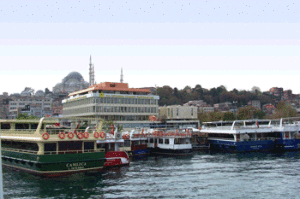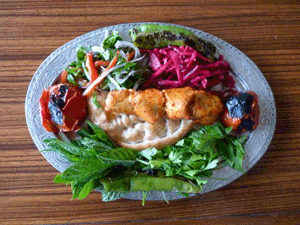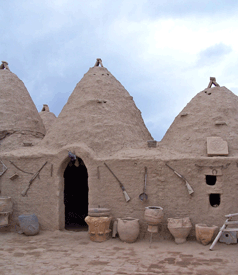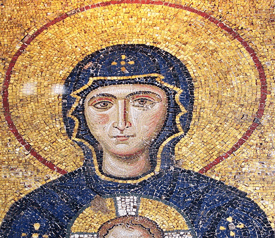Text ©2013
Photos ©2013 by Sal Laterra

Boats on the quay, Istanbul
I have two strong recollections of my first visit to Turkey more than four decades ago.
In Istanbul I stayed in the Youth Hostel overlooking the Bosphorus. Then and there, I decided that Istanbul must be one of the most beautifully situated cities in the world. Forty years, and many cities later, I still feel the same.
And, on that long ago visit, I ate in a Turkish home, and was served a pudding made, I was told, of shredded chicken breasts. Chicken breasts to make pudding? Outlandish! But that was before I had tasted my first spoonful of Tavuk gögsü Kazandibi. Like the Youth Hostel’s overlook onto the Bosphorus, I have never forgotten that scrumptious pudding made of chicken breasts, rice and sweetened milk. The Turks are rightly proud of their delectable sweets.

Turkish fare
Now I am just back from another visit to Turkey. This time I was there in pomegranate season. At virtually every street stand in Istanbul, fresh pomegranate juice was quenching the thirst of locals and tourists. Here and there, as I traveled to Gaziantep in the south — the epicurean capital of the country, I would see red pomegranates bobbing on trees. But my first stop on this trip was Cappadocia, with its landscape of caves and arches and pyramids of stone and its honey-colored “fairy chimneys” — pinnacles of volcanic ash that lost their lava coating centuries ago.
I stayed in a cave B & B called Sefa House in Ortahisar. For my first breakfast, on a terrace overlooking the pinnacles, I had fresh-squeezed pomegranate juice, along with string cheese, salty white goat cheese, garden tomatoes, cucumbers and peppers, yogurt, honey and jam, a hard-boiled egg, black olives, bread and tea. At lunchtime, there were pomegranate seeds sprinkled on my salad. I was told that their boiled down juice — nareksisi juice — was a fine substitution, too, for vinegar in salads. And pomegranate seeds are also eaten out of hand like pistachio nuts, another favorite food of Turkey.

Hot air balloons over Cappadocia, Turkey
In Cappadocia, I took a Royal hot-air balloon ride for a better view of the landscape, and when we were safely on the ground again, we 16 passengers were given souvenir medals for our bravery in going ballooning. Then we were feted with glasses of Emir, a Turkish sparkling wine. Despite being a Muslim country, Turkey does have vineyards and wineries. Among the up-and-coming ones where I was in Cappadocia are Köcabag in Urcisar and Turasan in Urgu.
The Okuzgözü of Köcabag is exceptionally good, according to a local oenophile, and has a flavor not unlike Zinfandel. The grapes from which it is made are fat and juicy. And then there is Bogazkere. Its name means “throat gripper” from the firm tannic streak in it. A particularly elegant Turkish wine, the oenophile says, is Kalecik Karasi with flavors that are fresh and exciting. But, she adds, the Turks prefer to drink wines made from international grape varieties, so visitors will always find Cabernet Sauvignon, Merlot, Shiraz, Chardonnay and Sauvignon Blanc either as pure varietals or blended with indigenous varieties.
A Pilsen-like beer is also a popular drink with foreigners. And then there is raki, the brandy of Turkey. One drinks it diluted with water, which turns it milky. Like its Greek look-alike — ouzo — it is licorice-flavored and very strong, but unlike ouzo this Turkish brandy is sweet. It is usually drunk at the start of a meal, as an accompaniment tomeze — the course of small portions that begins a Turkish meal. In this increasingly conservative Muslim country, however, alcoholic beverages (forbidden in the Koran) are not found everywhere and are highly taxed. In ordinary eateries, beverages are non-alcoholic. They may be carbonated drinks or juiced (along with orange, pomegranate and cherry juice, turnip juice is popular). Then there is thirst-quenching Ayran — diluted yogurt seasoned with a touch of salt. And, of course, tea — Çayi — apple tea, raspberry and blackberry, lemon and linden, as well as caffeinated black tea and thick, sweet Turkish coffee Kahvesi.
Since I was staying in Ortahisar, I was taken to the caves where lemons and oranges, picked green in the southwestern part of the country, are brought and left to ripen.
My Cappadocian visit also took me to the Goreme Open Air Museum — a UNESCO World Heritage site. There, in cave churches, some dating from as long ago as the ninth century, are Byzantine frescoes of Old and New Testament scenes. There are also the cells of long ago monks who lived high up in the rocks, far away from ordinary folk. It was not until the mid-sixth century that the honey-comb-like edifices of Cappadocia were discovered by a representative of Louis XIV of France and made known to the European world. Although the best known of the churches are in Goreme (and, therefore, the most heavily visited), there are others in the region.
As well as cave churches, Cappadocia is an area of underground cities. At Derinkuyu are underground cities visitors (who are not claustrophobic) may explore. These were the hideouts of Christians fleeing Persian and Arab armies in the 6th and 7th centuries and, bent double, one can wind one’s way through the passageways and rooms that they dug.
In Urgup, I sampled the meze menu one afternoon at a bustling little restaurant called Ziggy’s, renowned for its Patatas Salatasi (potato salad), and Kozde Patheran (charcoal-grilled eggplant). A meze served everywhere is Ezme — a spicy tomato, green pepper, cucumber and onion salad. Other popular meze are white goat cheese, olives, stuffed mussels, Cerkez Tavugu (chicken on a skewer), and Circassian (chicken in a walnut sauce).
A grander Cappadocian restaurant was Mut, also in Urgup where Topri, eggplant stuffed with leeks, currants, pistachios and humus, and a sorrel salad with stuffed dates were both particularly delectable, along with the figs stuffed with walnuts for dessert.

Stone head on Mount Nemrut, Turkey
From Cappadocia, a companion and I went south to Gaziantep (familiarly known as”Antep”). We made a side trip en route to Mount Nemrut to see the monumental stone heads erected there between 64 and 38 B.C. by King Antiochus I Theos, then ruler of the area. To reach the mountaintop, which was to be the ruler’s burial place, the king had terraces cut. Since it is said that one should be at the mountaintop just as the sun rises, it was still dark when we scrambled and sometimes crawled the 6,966 feet up the slippery, pebbly steps. Besides the stone head of the king, heads of Greek and Persian gods, a lion and an eagle came into view with daylight. On the way down, we warmed up with Turkish coffee at a kiosk. We had reached the mountain base by bus and by bus we continued on to Gaziantep.
Gaziantep is said to be the culinary capital of Turkey, and we lunched there in an enormous converted caravanserai before heading for the Archeological Museum filled with Roman mosaics dating from 64 B.C. unearthed during an irrigation project. Most of these floor and wall mosaics of mythological and underwater scenes that decorated villas when this was a garrison town are in superb condition.
Strolling the streets in this area renowned for its pistachios, we noticed that they frequently topped the sweet baklava in the nearly 200 pastry shops of Gaziantep. And, of course, there were mounds of pistachios in the bazaar and in food shops along the streets. Gaziantep is also in vineyard country and is known for its pekmez, grape molasses.
Our next stop was Sanliurfa (Urfa). There, Muslim legend has it, the prophet Abraham was born in a cave. When he grew to adulthood and challenged the Assyrian king’s worship of idols, he was captured, condemned to death and thrown onto a fire. But God saved him and he is said to have been lifted from the burning coals and landed in a rose garden below the fortress where he was being burned. Meanwhile, the embers from the fire were turned into carp whose descendants, never to be touched, still swim in two picturesque pools in the city. Anyone who injures them, according to the legend, will go blind.
It was holiday time when I was there and the park abutting the canal, as well as the rose garden there, were filled with vacationing families.
Often , in this southern, religiously conservative part of the country, the women have black chadors covering their faces.
We dined there on Kuru Içli Kofte, ground lamb croquettes covered with bulgur and fried in hot fat, and Urfa kebab — lamb chunks grilled on a skewer with onions and tomatoes and hot peppers. An Urfa specialty that we did not try was Cig Kafta, meatballs of raw ground lean mutton, tomatoes, tomato paste, onions, garlic and red and black pepper. This specialty, too, is a part of the Abraham legend. The king who condemned him to death by fire forbade the building of any other fires, so the wife of a hunter, knowing her husband would come home hungry for a good meat dinner, made meatballs from a gazelle he had previously killed, bulgar and hot pepper, and it has been an Urfa specialty ever since.
The restaurant where we ate was one spacious room covered with cushions and carpets and tables set so low to the floor that only by assuming a yoga position, or squatting, could one be aligned with the table, There was also Patlicanli Pilav (rice with eggplant Bostana), a salad of pomegranate seeds, parsley, tomato, red pepper and mint leaves with a dressing of pomegranate juice and salt. Our dessert was Shalik, a regional dessert made from walnuts. Urfa is also known for its bitter coffee that is boiled, it is said, for two days. It is so strong that one can drink only one or two sips. And it is important not to put the glass on the table because a glass on the table must be filled with gold.
In Urfa, we also explored the endless bazaar, sometimes open, sometimes covered, where one could buy beaded leather slippers with pointed toes, and hammered copper, carpets and silk scarves, Turkish delight and pastries. There were mounds of spices and dried apricots and nuts, and, of course, stalls of household goods of all kinds.

Beehive-like mud huts in Harran (note the rifles on the wall)
From Urfa, we traveled to Harran where Abraham is said to have lived for a time, and where there are curious beehive-like brick and mud and grass houses, whose design may date as far back as the second century B.C. Most are now empty, for better housing has been provided, but the homes are preserved as an important historic site. Today, half of the cotton produced in Turkey is grown in the Harran area and we often passed trucks and donkeys loaded with bags of it. We were then at the Syrian border and refugees were just disembarking from a mini-van outside the white tents of a refugee camp.
Istanbul was my final stop on this Turkish visit. Now a city of 1.5 million people, it was founded by Constantine the Great in 360 A.D. and named Constaninople for him. It retained that name until 1930. It is a city cut in two by the Strait of Bosphorus, with part of it in Europe, part in Asia, and was, indeed, named Cultural Capital of Europe in 2010.
I stayed this time in the Blue House Hotel in Sultanahmet, the touristic center of the Old Town. It was a fine hotel, but the view from my window didn’t hold a candle to my view so long ago from the Youth Hostel.

The first morning, I visited the sixth-century Church of Hagia Sophia that was built by the Roman emperor Justinian. His plan was to have it constructed with such magnificence that nothing like it would ever have been seen before and would never be seen afterwards. It was, indeed, heralded as the finest church in Christendom until the Turks conquered Constantinople in 1453 and transformed Hagia Sophia into a mosque. Today it is a museum. It is notable for its enormous dome — one of the largest in the world — and its mosaic panels and medallions of Christ accompanied by emperors, the Virgin Mary and John the Baptist. Some of these are in their original places, others removed to Hagia Sophia’s second floor mosaic museum.
I walked from there to the Blue Mosque, just 10 minutes away. It was constructed between 1006 and 1016 with six soaring minarets and an enormous courtyard to outdo Hagia Sofia. It was Sultan Ahmed I who had it constructed and its proper name is the Sultan Ahmed Mosque. It is known as the Blue Mosque however, because of the thousands of blue tiles from the ceramic city of Iznik that decorate its interior walls. The Blue Mosque continues to be an active mosque and, therefore, is not open to tourists at all times of day.
Topkapi Palace was my next stop on my all-too-brief three-day visit to Istanbul. To reach it, I crossed the Hippodrome that today is a park area, but in Roman times was the site of chariot races. Two of its highlights are two obelisks — one from Karnak in Egypt; the other a 14th-century obelisk of uncertain origin. It is known as the Rough Stone Monument because the gilded bronze covering it once had was torn off in a Crusade. Kaiser Wilhelm’s Fountain, given by Gemany’s Kaiser Wilhelm I in 1901 is also a Hippodrome highlight.
When I reached the enormous palace that was built between 1359 and 1466, it was hard to decide which of the many pavilions to visit. There is the Royal Mint, the Imperial Treasury, ,the Imperial Costume Pavilion, the Clock Pavilion, the 400-room Harem and many, many more from which to choose. The palace cafeteria overlooks the Bosphorus and, on a fine day, is a perfect place for dining outdoors.
My final destination in the Old Town was the Grand Bazaar of more than 3,000 shops that is the largest covered marketplace in the world. I had been lost in Urfa’s immense marketplace, but the Grand Bazaar is far, far bigger. The same sorts of items are on sale — decorative leather slippers and silk scarves, hand-embroidered silk pillowcases, gold and silver jewelry, Iznik ceramic bowls and cases, and, of course, items for everyday living for Turks.
For dinner that night, I sampled Pide, which some call a Turkish equivalent of pizza. It is oval shaped and buttered, with toppings that may include spinach, cheese, ground lamb or egg or a combination, as one chooses. Another flatbread is Lahmacun which is thin and soft and topped with ground beef or lamb, parsley, onions, chopped tomatoes and peppers. Street food, of course, is available everywhere. Börek, a pastry filled with meat or cheese, spinach or potatoes, is especially popular.
The next day I explored the New District of high-fashion shops like Prada and Louis Vuitton. It is also an area of elegant hotels and snappy, stylish hotels catering to visiting businessmen. I went on a brief Bosphorus cruise and, since I was on the waterfront, sampled one of the fresh fish sandwiches for which waterfront restaurants and takeaways are famed.
Though it was much too soon, after three days, my visit to Istanbul was ended and it was time to return to the United States. In Istanbul, I had missed the 16th-century Mosque of Suleiman the Magnificent that challenges the Blue Mosque in grandeur. I had missed the Turkish and Islamic Arts Museum. I had not spent an afternoon in a hammam — a Turkish steam bath. Nor had I sailed into the city on the Bosphorus at daybreak so I could see the sun rise on its mosques and minarets. I had not crossed over the Golden Horn on the Galata Bridge and looked down on the Old City.
And there is so much more still to see elsewhere in Turkey — Ephesus with its library that dates back to 114 A.D., and the remains of the house that is said to have been where the Virgin Mary once lived; the Gallipoli peninsula; the Ottoman town of Safranbolu; the beaches. The sights to see in Turkey are, indeed, endless; the variety of foods to sample equally endless.
& & &
